Benedicts test Study guides, Revision notes & Summaries
Looking for the best study guides, study notes and summaries about Benedicts test? On this page you'll find 110 study documents about Benedicts test.
Page 2 out of 110 results
Sort by
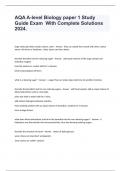
-
AQA A-level Biology paper 1 Study Guide Exam With Complete Solutions 2024.
- Exam (elaborations) • 20 pages • 2024
-
- £6.51
- + learn more
large molecules often contain carbon. why? - Answer they can readily form bonds with other carbon atoms. this forms a 'backbone'. other atoms can then attach. describe benedicts test for reducing sugars - Answer add equal volumes of the sugar sample and benedicts reagent. heat the mixture in a water bath for 5 minutes. brick red precipitate will form. what is a reducing sugar? - Answer a sugar that can reduce (give electrons to) another chemical. describe the benedicts test fo...
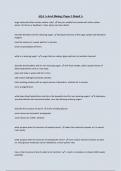
-
AQA A-level Biology Paper 1 Rated A
- Exam (elaborations) • 19 pages • 2024
-
- £10.58
- + learn more
AQA A-level Biology Paper 1 Rated A large molecules often contain carbon. why? they can readily form bonds with other carbon atoms. this forms a 'backbone'. other atoms can then attach. describe benedicts test for reducing sugars reagent. add equal volumes of the sugar sample and benedicts heat the mixture in a water bath for 5 minutes. brick red precipitate will form. what is a reducing sugar? a sugar that can reduce (give electrons to) another chemical. describe the ...
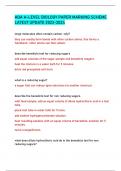
-
AQA A-LEVEL BIOLOGY PAPER MARKING SCHEME LATEST UPDATE 2023-2024
- Exam (elaborations) • 25 pages • 2024
-
- £11.31
- + learn more
AQA A-LEVEL BIOLOGY PAPER MARKING SCHEME LATEST UPDATE large molecules often contain carbon. why? they can readily form bonds with other carbon atoms. this forms a 'backbone'. other atoms can then attach. describe benedicts test for reducing sugars add equal volumes of the sugar sample and benedicts reagent. heat the mixture in a water bath for 5 minutes. brick red precipitate will form. what is a reducing sugar? a sugar that can reduce (give electrons to) another chemical. describe ...
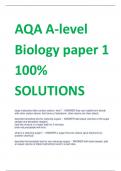
-
AQA A-level Biology paper 1 100% SOLUTIONS
- Exam (elaborations) • 15 pages • 2023
-
- £8.14
- + learn more
large molecules often contain carbon. why? - ANSWER they can readily form bonds with other carbon atoms. this forms a 'backbone'. other atoms can then attach. describe benedicts test for reducing sugars - ANSWER add equal volumes of the sugar sample and benedicts reagent. heat the mixture in a water bath for 5 minutes. brick red precipitate will form. what is a reducing sugar? - ANSWER a sugar that can reduce (give electrons to) another chemical. describe the benedicts test for non ...
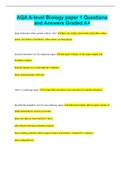
-
AQA A-level Biology paper 1 Questions and Answers Graded A+
- Exam (elaborations) • 33 pages • 2023
- Available in package deal
-
- £8.14
- + learn more
AQA A-level Biology paper 1 Questions and Answers Graded A+ large molecules often contain carbon. why? they can readily form bonds with other carbon atoms. this forms a 'backbone'. other atoms can then attach. describe benedicts test for reducing sugars add equal volumes of the sugar sample and benedicts reagent. heat the mixture in a water bath for 5 minutes. brick red precipitate will form. what is a reducing sugar? a sugar that can reduce (give electrons to) another chemical. describe th...
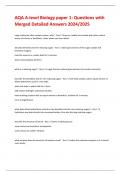
-
AQA A-level Biology paper 1: Questions with Merged Detailed Answers 2024/2025
- Exam (elaborations) • 21 pages • 2024
-
- £9.36
- + learn more
Large molecules often contain carbon. why? - Ansthey can readily form bonds with other carbon atoms. this forms a 'backbone'. other atoms can then attach. describe benedicts test for reducing sugars - Ansadd equal volumes of the sugar sample and benedicts reagent. heat the mixture in a water bath for 5 minutes. brick red precipitate will form. what is a reducing sugar? - Ansa sugar that can reduce (give electrons to) another chemical. describe the benedicts test for non-reducing sugar...
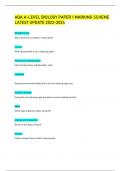
-
AQA A-2024LEVEL BIOLOGY PAPER 1 MARKING SCHEME LATEST UPDATE 2023-
- Exam (elaborations) • 19 pages • 2024
-
- £11.31
- + learn more
AQA A-2024LEVEL BIOLOGY PAPER 1 MARKING SCHEME LATEST UPDATE 2023- Benedict's test Which food test is heated in a water bath? Sucrose Which disaccharide is not a reducing sugar? Test for non-reducing sugars Add acid. Neutralise. Add Benedicts. Heat. Hydrolysis Reaction performed by dilute HCl in the non reducing sugar test. Glucose + fructose During the non-reducing sugar test what is sucrose hydrolysed into? Alpha Which type of glucose makes up starch? amylose and amylopectin Nam...
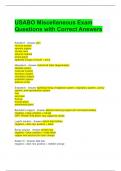
-
USABO Miscellaneous Exam Questions with Correct Answers
- Exam (elaborations) • 6 pages • 2024
-
- £10.58
- + learn more
USABO Miscellaneous Exam Questions with Correct Answers Ectoderm - Answer-skin nervous system sensory organs cornea, lens adrenal medulla pineal gland epithelial linings of mouth + anus Mesoderm - Answer-notochord (later degenerates) skeletal system muscular system excretory system circulatory system lymphatic system adrenal cortex Endoderm - Answer-epithelial lining of digestive system, respiratory system, urainry system, and reproductive system liver pancreas thymus t...
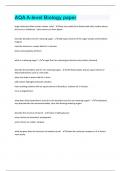
-
AQA A-level Biology paper | Questions With 100% Correct Answers | Verified
- Exam (elaborations) • 20 pages • 2023
- Available in package deal
-
- £12.61
- + learn more
large molecules often contain carbon. why? - they can readily form bonds with other carbon atoms. this forms a 'backbone'. other atoms can then attach. describe benedicts test for reducing sugars - add equal volumes of the sugar sample and benedicts reagent. heat the mixture in a water bath for 5 minutes. brick red precipitate will form. what is a reducing sugar? - a sugar that can reduce (give electrons to) another chemical. describe the benedicts test for non reducing sugars - with fo...
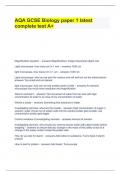
-
AQA GCSE Biology paper 1 latest complete test A+
- Exam (elaborations) • 9 pages • 2023
-
- £8.14
- + learn more
AQA GCSE Biology paper 1 latest complete test A+ Magnification equation - answers Magnification= image size/actual object size Light microscope- how many um in 1 mm - answers 1000 um light microscope- how many nm in 1 um - answers 1000 nm Light microscope- why can we see the nucleus and cell wall but not the mitochondria - answers Too small and not stained light microscope- how can we see smaller parts of cells - answers An electron microscope has muc...

That summary you just bought made someone very happy. Also get paid weekly? Sell your revision notes on Stuvia! Discover all about earning on Stuvia


